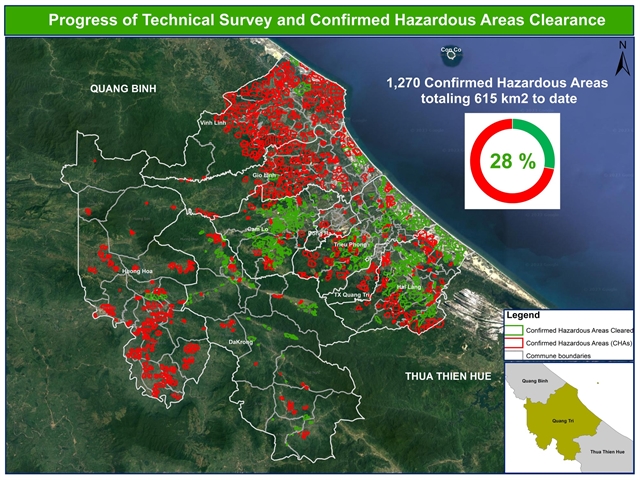 Society
Society

 |
| Map illustrating the progress of confirmed hazardous areas (CHAs) clearance by INGOs as of 16 April 2023. — Photo courtesy of Norwegian People's Aid (NPA) Việt Nam |
QUẢNG TRỊ — The central province of Quảng Trị, the most severely contaminated place for bombs and mines in Việt Nam, has completed a survey of cluster bomb remnants in all accessible areas since its launch eight years ago, reported Norwegian People's Aid (NPA) Việt Nam on April 18.
Specifically, NPA Việt Nam has identified a total of 1,270 hazardous areas with a total land coverage of 615 sq. km contaminated with cluster bombs. Some 173 sq.km have been cleared by international non-governmental organisations and the provincial military high command, and the remainder are being categorised for future removal.
The survey was carried out by NPA Việt Nam, the Restoring the Environment and Neutralising the Effects of the War (RENEW) project, the Mines Advisory Group (MAG) and PeaceTrees Việt Nam (PTVN) which also engaged in the clearance of landmines with funding from the US Department of State.
Quảng Trị has the highest proportion of landmine contamination in the country, with 82 per cent of the total land area affected. Unexploded ordnance (UXO) has caused over 3,430 deaths and 5,100 injuries in Quảng Trị Province.
With a very high level of damage, cluster bombs left over from the war against American aggression in the 60-70s last century have caused 48.3 per cent of the accidents in Quảng Trị since the reunification of the country in 1975.
According to the provincial Mine Action Centre, bombs, mines and unexploded ordnance (UXO) have caused casualties to 8,584 people since 1975, including 3,363 deaths. Among the total casualties, children under 16 years old accounted for 31 per cent.
Quảng Trị aims to become the first province in the country to be "safe" from UXO by 2025.
To achieve this goal, in 2022-25 period, the province aims to clear around 3,000ha of land contaminated with landmines on average each year, mobilise foreign non-governmental organisations to provide US$10 million per year to address the consequences of landmines, and complete 100 per cent of the surveying of cluster bomb and make public announcements on areas identified as dangerous due to landmine contamination, as well as develop human resource development policies for mine action work. — VNS




